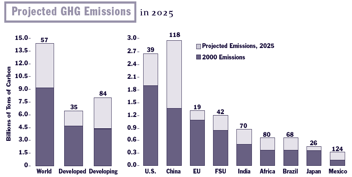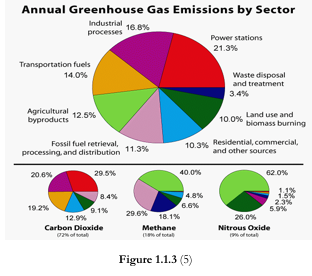Team:Wisconsin-Madison/Significane
From 2009.igem.org
SIGNIFICANCE
|
Problem
|
Biofuels as a Possible Solution
|
PROBLEM Climate Change Global warming is a socioeconomic problem that has received a great deal of attention in the past decade. Despite the attention, global leaders have not laid out a clear solution or set of solutions to combat this problem. Between 1905 and 2005 the global average surface temperature increased by 0.74 ± 0.18 °C (1). Global warming is undisputable and data implicates the role of greenhouse gasses in this process.
The warming climate is expected to bring about changes associated with perturbations in weather patterns, including: 1) flooding and drought (7); 2) continued desertification of subtropical regions (8); 3) an increase in the frequency of extreme weather events (7); 4) an increase in the range of disease vectors such as mosquitoes, which harbor diseases like malaria and dengue fever (9); 5) rising atmospheric carbon dioxide levels which reduces the pH of bodies of water (10); and 6) the melting of glacial and polar ice, which will raise sea levels worldwide (8). According to a paper “Extinction risk from climate change” published in Nature, 15-37% of species may be extinct by 2050 due to the effects of climate change (11). Biofuels may pose a long-term solution to global warming by reducing carbon emissions.
Fossil fuels constitute a declining non-renewable resource for which a replacement must be found. Based on current estimates by the United States Department of Energy, there exist proved reserves for 43 years of oil, 61 years of natural gas, and 148 years of coal at the current rate of consumption in 2006 (21). However, consumption rates are generally increasing faster than new reserves are being identified, lending a perspective that reserves will be depleted faster than currently estimated.
Water is one of the world’s scarcest renewable resources. Access to drinking water around the world is a continuous problem; approximately 1.1 billion individuals (18% of the world population) lack access to safe drinking water (20). With the continual increase in population, ground water is already consumed faster than it is replenished, especially in highly developed nations such as United States and China (20). If water consumption continues at its current rate, it is estimated that by 2025 nearly two-thirds of the world population will experience at least moderate water stress (20).
BIOFUELS AS A POSSIBLE SOLUTION Biofuels are energy sources recovered from living or recently dead biological matter. Although biofuels may be used in many of the same ways fossil fuels are used today, they have particular promise as fuels for transportation. Biofuels created from agriculturally grown crops are known as agrofuels, and include: sugarcane, corn, soybean, and switchgrass. Additionally, biofuels can be synthetically produced by engineered microorganisms; increased use of these engineered microorganisms is one aspect of our project. The biofuel process is ideally a carbon neutral cycle since any carbon dioxide released in the combustion of the fuel is recaptured by the next generation of fuel sources (Figure 1.2.1). Figure 1.2.1 (12)
The Energy Independence and Security Act of 2007 set a goal of 36 billion gallons of renewable fuels by the year 2022 (13). Our project will help to provide an alternative to corn ethanol in helping to meet this goal. Such processes are encouraged through methods such as government subsidies (13). Corn ethanol is the current approach to reaching this goal. Unfortunately, corn ethanol has several disadvantages. It is debated whether corn ethanol results in fewer greenhouses gas emissions than gasoline or even if it is energy favorable. A study at Cornell University states that corn ethanol costs 30% more energy to produce than the actual energy it contains (14). A study published in the Proceedings of the National Academy of Sciences states that there is some 25-40% energy favorability in corn ethanol production (15). Ethanol production has drastically increased the demand for corn and in 2008 corn prices more than doubled between January and July (16). One of the major limitations of this approach is that only the starch contained within the kernel of the corn is used to create ethanol; the rest of the plant is not converted into fuel.
Cellulosic biofuel production uses cellulose as well as starches and simple sugars to create biofuel. This process should result in increased production efficiency (over corn ethanol) since a higher percentage of the plant is converted into fuel. Cellulose is the most abundant carbon source on the planet, accounting for about 33% of plant matter (17). A cellulosic approach to biofuels has a greater variety of possible sources to better fit specific regions or methods. In his State of the Union address on January 23, 2007 former President George W. Bush set a production goal of 20 billion gallons of cellulosic ethanol a year by 2017.
Many biofuels are produced by converting monosaccharides into short chain alcohols, including ethanol. Polysaccharides, such as cellulose, can be broken down into monosaccharides for this process by either cellular (e.g. fermentation) or external catalytic means (18). Microbes are currently used to produce many alcohol biofuels, including ethanol or butanol (19). Using the techniques of molecular biology to engineer microbial genomes makes it possible to increase the efficiency of fermentation routes to biofuels.
The production of biofuels whether through particular microbial or cellulosic means consumes vast amounts of fresh water. This intense process requires at least five times more water than currently used to produce an equivalent amount of fuel from crude oil. Ultimately, more environmentally and water friendly methods must be employed for sustainable biofuel production. Ideally salt water or even untreated fresh water could be ideal sources of water for fuel synthesis, especially since salt water constitutes 97.5% of all water on the planet. Therefore, a prospective improvement to the biofuel synthesis process would be to engineer a microorganism capable of biofuel production in less than ideal water environments such as those of high ionic strength. |
1. IPCC, 2007: Summary for Policymakers. In: Climate Change 2007: The Physical Science Basis. Contribution of Working Group I to the Fourth Assessment Report of the Intergovernmental Panel on Climate Change [Solomon, S., D. Qin, M. Manning, Z. Chen, M. Marquis, K.B. Averyt, M.Tignor and H.L. Miller (eds.)]. Cambridge University Press, Cambridge, United Kingdom and New York, NY, USA.
2. IPCC. Climate Change 2007: Synthesis Report. November 2007. 01 March 2009 <http://www.ipcc.ch/pdf/assessment-report/ar4/syr/ar4_syr.pdf>.
3. Lerner, Brenda Wilmoth, and K. Lee Lerner. Environmental issues: Essential Primary Sources. Detroit: Thomson Gale, 2006.
4. “Climate Data: Insights and Observations.” PewClimate.org. June 2004. Pew Center on Global Climate Change. 8 March 2009 <http://www.pewclimate.org/docUploads/Climate%20Data.Paper.pdf>
5. Globalwarmingart.com. June 2006. Global Warming Art. 9 March2009 <http://www.globalwarmingart.com/wiki/Image:Greenhouse_Gas_by_Sector_png>
6. United States. U.S. Energy Information Administration. Petroleum Prime Supplier Sales Volumes. 30 Sept. 2008. 15 March 2009 <http://tonto.eia.doe.gov/dnav/pet/pet_cons_prim_dcu_nus_a.htm>
7. Solomon, S.; et al. “Irreversible Climate Change Due to Carbon Dioxide Emissions.” Proceedings of the National Academy of Sciences 106 (2009): 1704-1709.
8. Pfleger, Brian. Personal Interview. 28 Feb. 2009.
9. Lu, Jian; et al. “Expansion of the Hadley Cell Under Global Warming.” Geophysical Research Letters 34 (2007) L06805.
10. Confalonieri, U., B. Menne, R. Akhtar, K.L. Ebi, M. Hauengue, R.S. Kovats, B. Revich and A. Woodward, 2007: Human health. Climate Change 2007: Impacts, Adaptation and Vulnerability. Contribution of Working Group II to the Fourth Assessment Report of the Intergovernmental Panel on Climate Change, M.L. Parry, O.F. Canziani, J.P. Palutikof, P.J. van der Linden and C.E. Hanson, Eds., Cambridge University Press, Cambridge, UK, 391-431.
11. NASA.gov. 13 March 2008. NASA Science. 28 March 2009 <http://nasascience.nasa.gov/earth-science/oceanography/ocean-earth-system/ocean-carbon-cycle?searchterm=ocean+dissolved+carbon>
12. Thomas, Chris D.; et al. “Extinction risk from climate change.” Nature 427 (2004): 145-148.
13. United States. First Session of the 110th Congress of the United States. Energy Independence and Security Act of 2007. 4 Jan. 2007. 7 April 2009
 "
"









